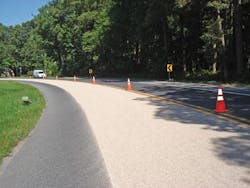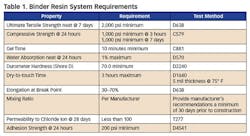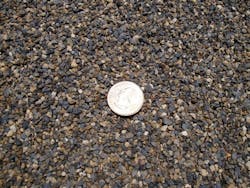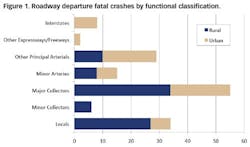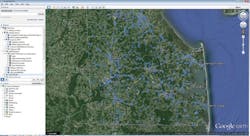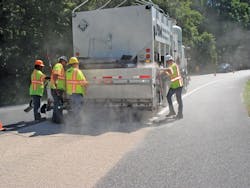The Delaware experience
Roadway departure crashes comprise approximately 56% of all fatal crashes nationwide, according to the Federal Highway Administration.
In Delaware, roadway departure crashes accounted for 40% of all traffic-related fatalities from 2007 through 2014 and 21% of all serious injury crashes in the state. A roadway departure crash is a crash that occurs after a vehicle exits its lane and crosses a centerline or edge line, or otherwise leaves the traveled way. These crashes are usually severe and typically involve a single vehicle departing the roadway and striking a fixed object or overturning. There are many safety countermeasures available to prevent or minimize the severity of these types of crashes. Those countermeasures include horizontal curve signage, centerline and edge-line rumble strips, guardrails and guardrail end terminals, provision of paved shoulders and many others. One type of countermeasure is best suited for addressing wet weather-related roadway departure crashes and is called high-friction surface treatment (HFST). Recently, the Delaware Department of Transportation (DelDOT) began a systemic safety improvement program (SSIP) to install HFST on roadways with risk factors similar to those where wet weather roadway departure crashes have occurred previously.
The skinny
High friction surface treatment (HFST) is a type of ultra-thin pavement overlay that utilizes an epoxy resin or polymer binder and high-quality, polish-resistant aggregate. The binder material is applied to a section of pavement and the aggregate is spread over the binder material. The aggregates are polish- and abrasion-resistant, leading to a higher pavement friction and longer-lasting overall friction number for the paved surface. Polishing of aggregates occurs when there is a lot of friction demand on a section of roadway, which typically occurs along horizontal curves. The aggregates and binder of the HFST form a pavement surface that provides improved friction and skid resistance. The additional skid resistance provided by this treatment allows motorists more opportunity to regain control of their vehicle, reduce their speed and stay on the roadway.
HFST is different from other types of pavement surface treatments such as chip sealing, microsurfacing, milling and grooving. HFST is designed to achieve very high friction numbers, up to 90 in some cases. Most states require a minimum friction number ranging 55-72 for HFST treatments at time of placement. The American Association of State Highway & Transportation Officials (AASHTO) recently released its standard specification for HFST which calls for a minimum friction number of 65 at time of placement.
These treatments can be used at spot locations where high friction demand, such as heavy braking, is necessary. Such locations include horizontal curves, steep downgrades and approaches to signalized or stop-controlled intersections.
DelDOT developed its specification for HFST after reviewing AASHTO’s standard specification and specifications from several other states across the nation. DelDOT requires the use of a polymeric resin binder which is a two-part thermosetting modified exothermic polymeric resin compound that holds the aggregate firmly in position. The binder must meet the requirements as shown in Table 1.
The aggregate that is used in Delaware’s HFST is calcined bauxite aggregate and is the most common type of aggregate used in HFST treatments across the country. Calcined bauxite is an aggregate that is derived from aluminum ore that when heated to a high temperature increases in physical hardness and stability. While there are other aggregates available such as flint, granite and steel slag, DelDOT opted to use the calcined bauxite since it has been used in the industry for a number of years and is proven for these types of treatments.
An example of applied calcined bauxite aggregate used in Delaware.
The material is applied using a truck-mounted application machine capable of mechanically mixing, metering, monitoring and applying the binder resin system and high-friction aggregate in one continuous pass.
In order to see the results of the HFST process prior to developing and letting a contract, DelDOT worked with DBi Services and Interstate Road Management on a test location. The goal of this test location was to see how the product was installed, how long it took to complete installation and to see what crash reduction benefits could be realized. The test location was Pyle Center Road, a rural collector roadway in Sussex County, where DelDOT had been receiving complaints regarding wet-weather crashes. A review of crash data for this particular location showed that there were eight wet weather-related crashes occurring within the curve on an annual basis.
The test location was installed in September 2013 and has since been exposed to two very harsh winter seasons. The findings show that the material is very durable and has withstood impacts from DelDOT plow trucks and applications of salt with little to no displacement of the aggregate and no removal of the resin binder material from the pavement surface. A post-crash analysis has shown a 75% reduction in wet weather-related crashes at this location.
Pavement sections where HFST is installed must be in relatively good condition with no cracking, raveling or scaling. Locations where pavement defects exist are patched prior to the installation of HFST. Concrete and asphalt surfaces must be clean and dry prior to installation of HFST; shot-blasting prior to installation is recommended.
Site selection and implementation
Unlike intersection-related crashes, roadway departure crashes in Delaware do not typically occur in clusters. Roadway departure crashes occur more randomly across the state’s roadway network. Using historic crash data, one can identify “hot spots” where roadway departure crashes occurred under wet pavement conditions and address those locations with HFST. However, in order to gain more of a crash-reduction effect, DelDOT is taking a systemic approach to implementing this treatment. The focus of systemic improvements is to address high-risk roadway features rather than specific high-crash locations. This allows for a proactive approach and a more comprehensive method for safety planning and implementation that compliments traditional site analysis.
The first step in developing a systemic safety improvement program is to identify target crash types (Figure 1). Through a review of all fatal crashes occurring between 2007 and 2009, it was found that 47% of the total fatal crashes that occurred in Delaware involved roadway departure. Delaware’s Strategic Highway Safety Plan (SHSP) indicates that a disproportionate number of roadway departure crashes occurred on collector and local roadways.
Crash data indicates similar trends for wet pavements. Forty-eight percent of fatal wet pavement condition crashes occurred on collector and local roadways, and 41% of total wet pavement condition crashes occurred on the same. While a significant portion of crashes occurred on collector and local roadways, only 32% of vehicle-miles traveled in 2005 through 2011 (representing the latest data available at the time of program development) occurred on these types of roadways, showing a preponderance of crashes on these types of roadways.
Figure 2. Wet weather roadway departure crashes in Sussex County, Del.
In the case of the HFST project, wet weather-related roadway departure crashes are the target crash type that DelDOT is attempting to address with this treatment. Further steps in developing the systemic approach to this project include identifying high-risk characteristics of where these crashes have occurred historically. As noted previously, these crashes are occurring at disproportionate rates on collectors and local roadways. DelDOT further reviewed crash data along these roadways to determine the segments with the highest wet pavement condition roadway departure crash rates and these were the segments that were initially screened to determine if HFST would be the appropriate countermeasure. All wet weather roadway departure crashes were analyzed, not just fatal crashes. Each location was further reviewed to determine the existing pavement condition, date of last resurfacing, date of next expected resurfacing and locations of any horizontal curves. Further consideration included coordination with DelDOT’s Maintenance & Operations and Pavement Management sections to determine if any future resurfacing projects were being considered. If a resurfacing project was being considered within a two-year timeframe, that location was removed from further consideration. Through the site selection process, the data found that these crashes primarily occurred within or on the approach to horizontal curves, making curves an additional risk factor in resulting analysis. Figure 2 provides a screenshot of mapped wet weather roadway departure crashes throughout Sussex County.
The first screening process yielded 48 candidate locations for installation of HFST and 15 initial locations were selected to be part of the first contract for implementation.
A three-year open-ended contract was developed for implementation of HFST throughout the state. The first 15 locations were included in the contract documents, the “known locations” and future locations are being added throughout the life of the contract. The contract was advertised on March 2, 2015 and awarded to Poly-Carb Inc. on May 6, 2015. Work began on the initial 15 locations in September 2015 and to date, all 15 locations have been completed.
While it is too early to tell from a crash reduction perspective if the treatment of the first 15 sites has been effective, DelDOT is nonetheless looking forward to reviewing further “after” crash data to fully determine the benefits of this treatment.
High-friction surface treatment spray application in action in the state of Delaware. The sprayer vehicle can put down the binder and aggregate in a single pass.
Future steps
As of June 2016, DelDOT is implementing HFST at eight additional locations, which will be completed by Fall 2016. Additional locations may be implemented in the 2017 construction season. Work cannot occur during the winter months since this process is temperature sensitive. Additional before/after crash analyses will be conducted within six months and 12 months from initial implementation of each location to determine what crash-reduction benefit has been realized.
In addition to applying the treatment to horizontal curves, DelDOT is considering installing the treatment on the departure side of a metal grate drawbridge within the city of Wilmington. The departure side of the Market Street drawbridge has experienced a high rate of wet weather-related crashes. The road surface is comprised of a metal grate deck with concrete in between the gratings. Under this pavement section exists the mechanical infrastructure that moves the bridge. The goal is to install this treatment on this small section of roadway to minimize wet weather-related crashes coming off of the bridge.
Finally, DelDOT is going to begin evaluating intersection approaches where there are high rates of rear-end crashes to determine if the HFST can be installed to minimize skidding approaching stop-controlled and signal-controlled intersections. One location will be implemented this summer based on a high rate of stop-sign running which appears to be related to skidding.
HFST is proving to be a valuable countermeasure that can be used to minimize wet weather roadway departure crashes. The overall goal of this program and other safety programs managed by DelDOT is to reduce all types of crashes and move Towards Zero Deaths.
